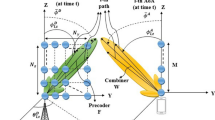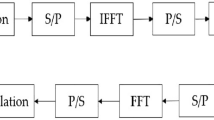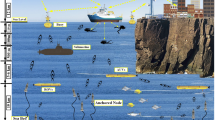Abstract
A small set of pilots in underwater acoustics OFDM (UWA-OFDM) systems tends to be insufficient for recovering the channel impulse response (CIR). This may result from the fast changes in the propagation environment and the requirement for high transmission data rates. A previous work, namely PE, considered the received subcarriers whose distances to their closest constellation points below the predetermined threshold T as potential pilots. However, extracting these pilots at the same time gives no chance to use some of them to facilitate searching for others. Fixing threshold T is also another limitation for searching pilot candidates. This paper proposes a reliable pilot search (RPS) method that consists of a multi-iterations pilot searching process with an adaptive threshold \(T_{a}\) to improve the estimator in UWA-OFDM. The pilot search process gradually extracts reliable pilots at each iteration based on the threshold \(T_{a}\) and evaluates them by performing channel estimation. Our method is compared to the MMSE and PE estimators on a wide range of settings, including the number of channel taps, pilot spacing, and various modulation schemes (i.e., MPSK and MQAM). The experimental results show that the RPS method often outperforms the MMSE and PE methods in terms of bit error rate (BER).













Similar content being viewed by others
References
R. Diamant, and L. Lampe, Low probability of detection for underwater acoustic communication: a review, IEEE Access, Vol. 6, pp. 19099–19112, 2018. https://doi.org/10.1109/ACCESS.2018.2818110.
P. Qarabaqi, and M. Stojanovic, Statistical characterization and computationally efficient modeling of a class of underwater acoustic communication channels, IEEE Journal of Oceanic Engineering, Vol. 38, No. 4, pp. 701–717, 2013. https://doi.org/10.1109/JOE.2013.2278787.
X. Lurton, and D. Jackson, An Introduction to Underwater Acoustics, 2 edn,Springer, Berlin, 2010. https://doi.org/10.1121/1.1639324.
L. Xu, and T. Xu, Digital Underwater Acoustic Communications, 1 edn,Academic Press, Boston, 2016. https://doi.org/10.1016/C2014-0-00624-7.
J. Tao, and Y. R. Zheng, Turbo detection for MIMO-OFDM underwater acoustic communications, International Journal of Wireless Information Networks, Vol. 20, pp. 27–38, 2013. https://doi.org/10.1007/s10776-012-0182-4.
R. Jiang, S. Cao, C. Xue, and L. Tang, Modeling and analyzing of underwater acoustic channels with curvilinear boundaries in shallow ocean. In: Proceedings of the ICSPCC, pp. 1–6, 2017. https://doi.org/10.1109/ICSPCC.2017.8242476.
B. Li, S. Zhou, M. Stojanovic, L. Freitag, and P. Willett, Multicarrier communication over underwater acoustic channels with nonuniform doppler shifts, IEEE Journal of Oceanic Engineering, Vol. 33, No. 2, pp. 198–209, 2008. https://doi.org/10.1109/JOE.2008.920471.
P. Vimala, and G. Yamuna, Pilot design strategies for block sparse channel estimation in OFDM systems, Indian Journal of Science and Technology, Vol. 10, pp. 1–6, 2017. https://doi.org/10.17485/ijst/2017/v10i24/110694.
J. A. Hildebrand, Anthropogenic and natural sources of ambient noise in the ocean, Marine Ecology Progress Series, Vol. 395, pp. 5–20, 2009. https://doi.org/10.3354/meps08353.
M. A. Chitre, S. Kuselan, and V. Pallayil, Ambient noise imaging in warm shallow waters; robust statistical algorithms and range estimation, The Journal of the Acoustical Society of America, Vol. 132, No. 2, pp. 838–847, 2012. https://doi.org/10.1121/1.4733553.
Y. Liu, Z. Tan, H. Hu, L. J. Cimini, and G. Y. Li, Channel estimation for OFDM, IEEE Communications Surveys & Tutorials, Vol. 16, No. 4, pp. 1891–1908, 2014. https://doi.org/10.1109/COMST.2014.2320074.
Q. Yu, W. Liu, S. Feng, Y. Yan, and Z. Shao, Channel estimation based on diagonal pilot in OFDM systems. In: 2015 IEEE International Conference on Information and Automation, pp. 245–249, 2015. https://doi.org/10.1109/ICInfA.2015.7279293.
M. Murad, I. A. Tasadduq, and P. Otero, Pilots based LSE channel estimation for underwater acoustic OFDM communication. In: 2020 Global Conference on Wireless and Optical Technologies (GCWOT), pp. 1–6, 2020. https://doi.org/10.1109/GCWOT49901.2020.9391633.
A. B. Singh, and V. K. Gupta, Performance evaluation of MMSE and LS channel estimation in OFDM system, International Journal of Engineering Trends and Technology, Vol. 15, pp. 39–43, 2014. https://doi.org/10.14445/22315381/IJETT-V15P209.
L. Bernadó, N. Czink, T. Zemen, and P. Belanović, Physical layer simulation results for IEEE 802.11p using vehicular non-stationary channel model. In: 2010 IEEE International Conference on Communications Workshops, pp. 1–5, 2010 . https://doi.org/10.1109/ICCW.2010.5503942.
J. A. Fernandez, K. Borries, L. Cheng, B. V. K. Vijaya Kumar, D. D. Stancil, and F. Bai, Performance of the 802.11p physical layer in vehicle-to-vehicle environments, IEEE Transactions on Vehicular Technology, Vol. 61, No. 1, pp. 3–14, 2012. https://doi.org/10.1109/TVT.2011.2164428.
Z. Zhao, X. Cheng, M. Wen, B. Jiao, and C. Wang, Channel estimation schemes for IEEE 802.11p standard, IEEE Intelligent Transportation Systems Magazine, Vol. 5, No. 4, pp. 38–49, 2013. https://doi.org/10.1109/MITS.2013.2270032.
P. Alexander, D. Haley, and A. Grant, Cooperative intelligent transport systems: 5.9-GHz field trials, Proceedings of the IEEE, Vol. 99, No. 7, pp. 1213–1235, 2011. https://doi.org/10.1109/JPROC.2011.2105230.
K. Yoon, O. Jang, S. Yoo, and M. Cheol, Time and frequency domain channel estimation scheme for IEEE 802.11p. In: 17th International IEEE Conference on Intelligent Transportation Systems (ITSC), pp. 1085–1090, 2014. https://doi.org/10.1109/ITSC.2014.6957832.
C. M. Jooyoung Choi, and Kang Yoo, MMSE channel estimation scheme using virtual pilot signal for IEEE 802.11p, Journal of Korean Institute of Information Technology, Vol. 27, No. 1, pp. 27–32, 2016.
J. Choi, H. Jo, C. Mun, and J. Yook, Preamble-based adaptive channel estimation for IEEE 802.11p, Sensors, 2019. https://doi.org/10.3390/s19132971.
S. Han, J. Park, and C. Song, Virtual subcarrier aided channel estimation schemes for tracking rapid time variant channels in IEEE 802.11p systems. In: 2020 IEEE 91st Vehicular Technology Conference (VTC2020-Spring), pp. 1–5, 2020. https://doi.org/10.1109/VTC2020-Spring48590.2020.9128435.
A. K. Gizzini, M. Chafii, S. Ehsanfar, and R. M. Shubair, Temporal averaging LSTM-based channel estimation scheme for IEEE 802.11p standard. In: 2021 IEEE Global Communications Conference (GLOBECOM), pp. 01–07, 2021. https://doi.org/10.1109/GLOBECOM46510.2021.9685409.
J. Pan, H. Shan, R. Li, Y. Wu, W. Wu, and T. Q. S. Quek, Channel estimation based on deep learning in vehicle-to-everything environments, IEEE Communications Letters, Vol. 25, No. 6, pp. 1891–1895, 2021. https://doi.org/10.1109/LCOMM.2021.3059922.
R. Jiang, X. Wang, S. Cao, J. Zhao, and X. Li, Deep neural networks for channel estimation in underwater acoustic OFDM systems, IEEE Access, Vol. 7, pp. 23579–23594, 2019. https://doi.org/10.1109/ACCESS.2019.2899990.
Y. Zhang, H. Wang, C. Li, D. Chen, and F. Meriaudeau, Meta-learning-aided orthogonal frequency division multiplexing for underwater acoustic communications, The Journal of the Acoustical Society of America, Vol. 149, pp. 4596–4606, 2021. https://doi.org/10.1121/10.0005474.
T. N. Nguyen, H. A. Phan, V. L. Cao, T. H. Nguyen, and P. T. Hiep, Pilot enrichment methods for improving quality of received signal in underwater acoustic OFDM systems. In: 2022 International Conference on Advanced Technologies for Communications (ATC), pp. 401–406, 2022. https://doi.org/10.1109/ATC55345.2022.9943030.
M. M. Awad, K. G. Seddik, and A. Elezabi, Low-complexity semi-blind channel estimation algorithms for vehicular communications using the IEEE 802.11p standard, IEEE Transactions on Intelligent Transportation Systems, Vol. 20, No. 5, pp. 1739–1748, 2019. https://doi.org/10.1109/TITS.2018.2834723.
Y. Jung, S. Byun, S. Shin, Han, S. Cho, and S. Lee, Frequency and symbol timing offset estimation method for CP-OFDM based system. In: 2021 International Conference on Information and Communication Technology Convergence (ICTC), pp. 599–601, 2021. https://doi.org/10.1109/ICTC52510.2021.9621185.
L. Liu, Y. Zhang, P. Zhang, L. Zhou, J. Li, J. Jin, J. Zhang, and Z. Lv, PN sequence based doppler and channel estimation for underwater acoustic OFDM communication. In: Proceedings of the ICSPCC, pp. 1–6, 2016. https://doi.org/10.1109/ICSPCC.2016.7753719.
P. Chen, Y. Rong, S. Nordholm, Z. He, and A. J. Duncan, Joint channel estimation and impulsive noise mitigation in underwater acoustic OFDM communication systems, IEEE Transactions on Wireless Communications, Vol. 16, No. 9, pp. 6165–6178, 2017. https://doi.org/10.1109/TWC.2017.2720580.
P. Tsai, and T. Chiueh, Frequency-domain interpolation-based channel estimation in pilot-aided OFDM systems. In: 2004 IEEE 59th Vehicular Technology Conference (VTC 2004-Spring), Vol. 1, pp. 420–424, 2004. https://doi.org/10.1109/VETECS.2004.1387987.
S. K. Khadagade, and N. K. Mittal, Comparison of BER of OFDM system using QPSK and 16QAM over multipath rayleigh fading channel using pilot-based channel estimation, International Journal of Engineering and Advanced Technology (IJEAT), Vol. 2, pp. 26–32, 2013.
Z. Wang, H. Wu, and S. Liu, An improved sparse underwater acoustic OFDM channel estimation method based on joint sparse model and exponential smoothing. In: 2017 IEEE International Conference on Signal Processing, Communications and Computing (ICSPCC), pp. 1–6, 2017. https://doi.org/10.1109/ICSPCC.2017.8242418.
L. Kewen, XingKe: Research of MMSE and LS channel estimation in OFDM systems. In: The 2nd International Conference on Information Science and Engineering, pp. 2308–2311, 2010. https://doi.org/10.1109/ICISE.2010.5688562.
M. B. Sutar, and V. S. Patil, LS and MMSE estimation with different fading channels for OFDM system. In: 2017 International Conference of Electronics, Communication and Aerospace Technology (ICECA), Vol. 1, pp. 740–745, 2017. https://doi.org/10.1109/ICECA.2017.8203641.
Y. S. Cho, J. Kim, W. Y. Yang, and C. G. Kang, MIMO-OFDM Wireless Communications With MATLAB, Wiley-IEEE Press, New York, 2010.
T. Taoliu, and H. Zhang, Improved channel estimation method jointing channel coding. In: 2019 3rd International Conference on Electronic Information Technology and Computer Engineering (EITCE), pp. 1624–1628, 2019. https://doi.org/10.1109/EITCE47263.2019.9094926.
P. C. Etter, Underwater Acoustic Modeling and Simulation, CRC Press, New York, 2018.
M. B. Porter, and H. P. Bucker, Gaussian beam tracing for computing ocean acoustic fields, Journal of the Acoustical Society of America, Vol. 82, No. 4, pp. 1349–1359, 1987.
M. B. Porter, The BELLHOP Manual and User’s Guide: Preliminary Draft. Heat, Light, and Sound Research, Inc., La Jolla, CA, USA, Technical Report, Vol. 260, 2011.
M. Porter, The KRAKEN Normal Mode Program. Naval Research Laboratory, Washington, DC, USA, Technical Report, Vol. 92–17722, 1992.
M. Siderius, and M. B. Porter, Modeling broadband ocean acoustic transmissions with time-varying sea surfaces, The Journal of the Acoustical Society of America, Vol. 124, No. 1, pp. 137–150, 2008. https://doi.org/10.1121/1.2920959.
Y. Zhang, J. Li, Y. Zakharov, X. Li, and J. Li, Deep learning based underwater acoustic OFDM communications, Applied Acoustics, Vol. 154, pp. 53–58, 2019. https://doi.org/10.1016/j.apacoust.2019.04.023.
M. Miron-Morin, D. R. Barclay, and J.-F. Bousquet, The oceanographic sensitivity of the acoustic channel in shallow water, IEEE Journal of Oceanic Engineering, Vol. 46, No. 2, pp. 675–686, 2021. https://doi.org/10.1109/JOE.2020.2997215.
K. M. Rizwan, D. Bikramaditya, and P. B. Bhusan, A criterion based adaptive RSIC scheme in underwater communication, Journal of Systems Engineering and Electronics, Vol. 32, No. 2, pp. 408–416, 2021. https://doi.org/10.23919/JSEE.2021.000034.
Author information
Authors and Affiliations
Corresponding author
Additional information
Publisher's Note
Springer Nature remains neutral with regard to jurisdictional claims in published maps and institutional affiliations.
Rights and permissions
Springer Nature or its licensor (e.g. a society or other partner) holds exclusive rights to this article under a publishing agreement with the author(s) or other rightsholder(s); author self-archiving of the accepted manuscript version of this article is solely governed by the terms of such publishing agreement and applicable law.
About this article
Cite this article
Nguyen, T.N., Phan, A.H., Cao, V.L. et al. Reliable Pilot Search Method for Enhancing BER Performance in Underwater Acoustic OFDM Systems with MMSE Estimator. Int J Wireless Inf Networks 31, 84–95 (2024). https://doi.org/10.1007/s10776-024-00621-5
Received:
Revised:
Accepted:
Published:
Issue Date:
DOI: https://doi.org/10.1007/s10776-024-00621-5




